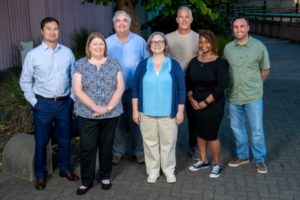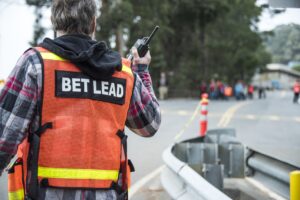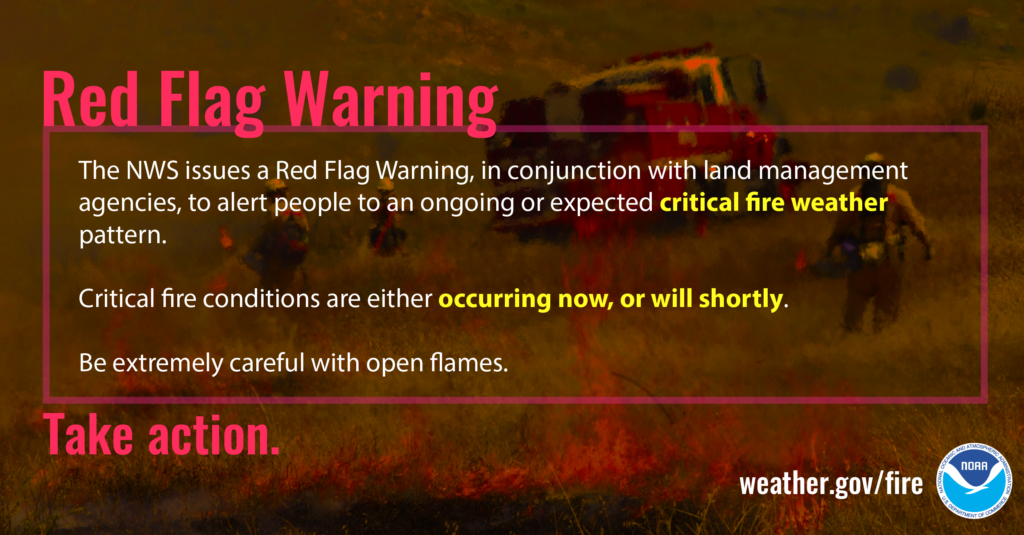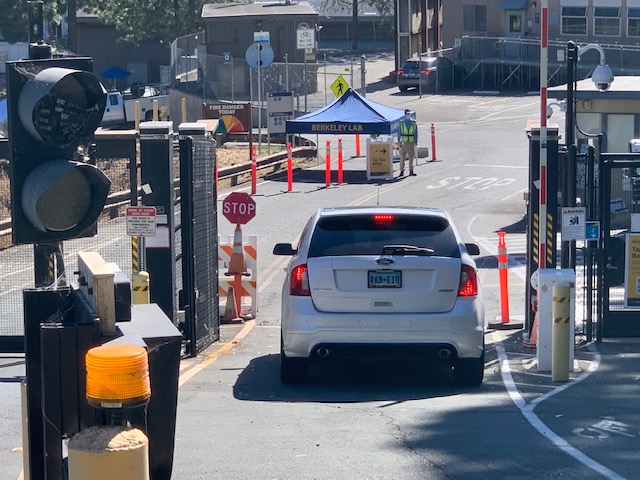
Drop to the ground, cover your neck and head, hold on to something sturdy until shaking stops.
Published on by Ayla Quesada.

Drop to the ground, cover your neck and head, hold on to something sturdy until shaking stops.
Published on by Luis Romo.

2024 Organizational Impact: Centennial Bridge Replacement Project – John Braithwaite, Suzanne Budd, Tammy Carlson, Orlando Casiano, Blair Edwards, Anthony Fernandez, Steven Filippoff, Timothy M. Hart, Jim Hawley, Nikki Humphreys, Igor Kligman, & Richard Lopatto
Citation: For visionary cross-functional teamwork to improve Lab safety and operations by replacing an earthquake-prone and landslide vulnerable hazard, the old Centennial Bridge, with an innovative viaduct solution that will serve and protect the Lab and the community for decades to come.
Published on by Ayla Quesada.
Building Emergency Teams, or BETs, have been a tremendous asset to the safety and emergency preparedness of Lawrence Berkeley National Laboratory.

However, the global COVID-19 pandemic brought a lot of unprecedented challenges to our Laboratory. Previously buildings may have had a BET Lead and BET members to help guide people to evacuate in an emergency; but now those people might be working remotely or on a hybrid schedule (or out sick for extended periods). Some buildings did not have any BET volunteers.
As The Way we Work has brought great benefits to business continuity and made the Lab more accessible, it has also introduced challenges in relying on an in-person institutional knowledge for critical safety roles.
In November 2021, Security & Emergency Services Division stood up the Critical Incident Management Group (CIMG). The CIMG is a trained and qualified incident management team using National Incident Management System standards. Led by an Incident Commander with overall authority, the CIMG is on call 24/7 to respond to incidents, emergencies, continuity events, and some planned events at the Lab. The formation of this team was one big step forward in safely managing incidents at the Laboratory.
We have also integrated mass notification (LabAlert) to issue protective actions (evacuate, shelter-in-place, or lockdown) and conduct personnel accountability, and drill this capability at least quarterly.
In December of 2023, the Emergency Management team held Town Halls to discuss our path forward and the
decommissioning of BETs. The BET concept is being evolved into the Community Preparedness Framework (CPF), and the term BET is being removed from SES related training, policy and plans.
Now, we want to reinforce that all site workers will be accountable for understanding and following protective actions issued by the CIMG. All personnel should:
We are also working on the following for FY25: updating evacuation assembly areas, site online emergency training, and the emergency guide.
If you have any questions about emergency preparedness or CPF, please email emergencymanagement@lbl.gov or join our monthly Open Office Hours.
Published on by Will Plascencia.
As we head into the hottest and driest months of the year, it’s a good time to familiarize yourself with words and phrases associated with fire season. Below we try to dispel misconceptions and answer some common questions about hot weather advisories, fire warnings, and smoke event alerts.

What’s the difference between a Fire Weather Watch and a Red Flag Warning?
Both Red Flag Warnings and Fire Weather Watches warn us about critical weather conditions, such as high winds and low humidity or dry lightning, that could lead to increases in wildfire activity. The difference between the two comes down to timing.
A Fire Weather Watch is issued when conditions are expected to occur within a three-day period. But the timeframe for a Red Flag Warning, the highest alert, is much shorter with conditions expected to occur within 24 hours.
What are dry thunderstorms and dry lightning?
Dry thunderstorms typically occur at high altitudes and during hot conditions where most, if not all, precipitation evaporates before reaching the ground. These storms are also likely to create dry lightning, which coupled with hot, dry conditions and increased fire fuels on the ground could spark wildfires.
What are the differences between watches, warnings and advisories when it comes to heat?
Timing, again, is a key difference for heat alerts but this time add a level of certainty and also factor in higher temperatures. A Heat Advisory or Outlook is the lowest alert and means you should prepare for high temperatures within the next 12 hours, but the forecast is unclear just how hot it will get.
Excessive Heat Watches are a notch up from an advisory. Heat watches are issued when conditions are favorable for an excessive heat event, with temperatures reaching into the 80s and 90s during the next 24 to 72 hours.
Excessive Heat Warnings are the highest alerts and are issued within 12 hours of the onset of extremely dangerous heat conditions, with temperatures approaching or exceeding 100 degrees. These warnings could last days or can be downgraded to a watch if dangerous conditions diminish.
Air Quality Advisories vs. Spare the Air.
Both Air Quality Advisories and Spare the Air alerts require you to take precautions, and possibly action to alleviate poor air conditions in the area.
Spare the Air Alerts can be issued because of an unhealthy level of air pollutants such as ozone or fine particles from smoke. If an alert is issued, try to limit outdoor activities. And if the Spare the Air alert is in effect because of fine particle pollution, do not burn wood or other solid fuels in fireplaces, stoves, or outdoor fire pits.
In the Bay Area, when an Air Quality Advisory is issued it’s usually because of a smoke event such as a man-made fire or wildfire. Advisories can be issued even if the local air quality index (AQI) is at normal levels because wildfire smoke can spread rapidly as weather patterns change.
Air Quality Advisories and Spare the Air alerts can often be issued simultaneously or back to back.
To track and learn more about local weather patterns and advisories go here:
For more information on how to protect yourself from heat check out these resources:
To learn about air quality and wildfire smoke try these resources:
More resources and links to consider:
Published on by Will Plascencia.
The Lab’s Grizzly Gate entrance will reopen July 5, allowing vehicles to both enter and exit for the first time since badging requirements were introduced during the pandemic.
Vehicles entering from Centennial Dr. will be allowed in weekdays from 6:00 a.m. to 10:00 a.m. Vehicles can exit from Grizzly Gate all day and every day. Pedestrians, and cyclists accessing the walk-in gate can enter and exit Grizzly Gate from 6:00 a.m. to 8:00 p.m.
“The opening of Grizzly Gate to incoming traffic is something we’ve been working hard to re-establish,” said Blair Edwards, the Lab’s Senior Security Operations Manager in charge of Physical Security and Protective Force. “We’ve taken steps to assure people can safely and efficiently access the Lab from this entry point. Speeding down Centennial Drive and making the tight turn into the Grizzly Gate driveway remain our top concern. Please take care when using this gate.”

New signs are up that advise vehicles to slow down when approaching Grizzly Gate from inside the Lab or entering from Centennial Dr. Once drivers or riders entering from Centennial Dr. clear the gate arm they will need to proceed to the tent where a security guard will ask them to swipe their badge for entry to the Lab.
Stop signs have also been installed to regulate traffic, so please be aware and adhere to all stop signs. In addition, exiting vehicles will need to go around the bus shelter island before exiting Grizzly Gate to Centennial Dr.
Here is a video of the new process for entering via Grizzly Gate.
For questions or concerns about the new procedures to enter and exit Grizzly Gate please contact the Site Operations Center at (510) 486-6999.
Published on by Ayla Quesada.
On Thursday, April 14 at approximately 9:30 a.m., the Lab’s Emergency Management Department will be testing the LabAlert system by sending cascading alerts to all Lab employees, affiliates, and contractors who have accessed the Lab’s hill site that morning. This drill is targeting only those who have badged in so Emergency Management can test different systems, as well as the ability to target recipients. Those who have badged in to other Lab sites in Berkeley and Emeryville, and those who are teleworking, will not be part of this drill.
If you are at the Lab’s hill site on April 14 and receive a LabAlert message, please respond with your status. The cascading alert starts by sending an email, then a text message to registered mobile devices, then a phone call. You will only need to respond to one of the messages, but it is critical that you do so. The notifications will continue until you respond.
This drill is part of the Department of Energy’s continuity of operations efforts. Participation in this drill will help keep you and your colleagues safe during an emergency.
The best way to receive emergency information is by enrolling your cell phone in the LabAlert system. LabAlert will be used during and after emergencies to broadcast safety information and instructions. If you have not registered your cell phone, or have not recently verified your information is still correct, please do so today. If you do not have a Lab-issued cell phone, please consider adding your personal cell phone to ensure you receive emergency messages when you are away from your desk. From your profile you can also change the order of how LabAlert sends you notifications; for example, you can elect to receive a text message first, then a phone call. It is also a recommended best practice to create a contact for LabAlert (510-486-6288) in your cell phone, and make it a “Favorite” (this will ensure that messages get through).
LabAlert messages can also:
Published on by Ayla Quesada.
On Thursday, February 10 at approximately 9:30 a.m., the Lab’s Emergency Management Department will be testing the LabAlert system by sending cascading alerts to all Lab employees, affiliates, and contractors who have accessed the Lab’s hill site that morning. This drill is targeting only those who have badged in so Emergency Management can test different systems, as well as the ability to target recipients. Those who have badged in to other Lab sites in Berkeley and Emeryville, and those who are teleworking, will not be part of this drill.
If you are at the Lab’s hill site on February 10 and receive a LabAlert message, please respond with your status. The cascading alert starts by sending an email, then a text message to registered mobile devices, then a phone call. You will only need to respond to one of the messages, but it is critical that you do so. The notifications will continue until you respond.
This drill is part of the Department of Energy’s continuity of operations efforts. Participation in this drill will help keep you and your colleagues safe during an emergency.
The best way to receive emergency information is by enrolling your cell phone in the LabAlert system. LabAlert will be used during and after emergencies to broadcast safety information and instructions. If you have not registered your cell phone, please do so today. If you do not have a Lab-issued cell phone, please consider adding your personal cell phone to ensure you receive emergency messages when you are away from your desk. It is also a recommended best practice to create a contact for LabAlert (510-486-6288) in your cell phone, and make it a “Favorite” (this will ensure that messages get through).
LabAlert messages can also:
Published on by Pamela Smith.
Published on by Melissa Banuelos.
Emergency Management is sponsoring a series of training classes for Lab employees who want to become a member of the Community Emergency Response Team (CERT). CERT members receive training in basic first aid, light search and rescue operations, basic fire suppression, and patient triage, treatment, and transportation.
There are 4 classroom training sessions (16 hours total) from 8 a.m. until noon on:
Tuesday, March 17
Thursday, March 19
Tuesday, March 24
Thursday, March 26
A final drill will be held Friday, April 3 from 8 a.m. until noon.
All classes are held in Building 90, Room 0026, basement level.
For more information or to register email Rhett Persaud.
Was this page useful?

